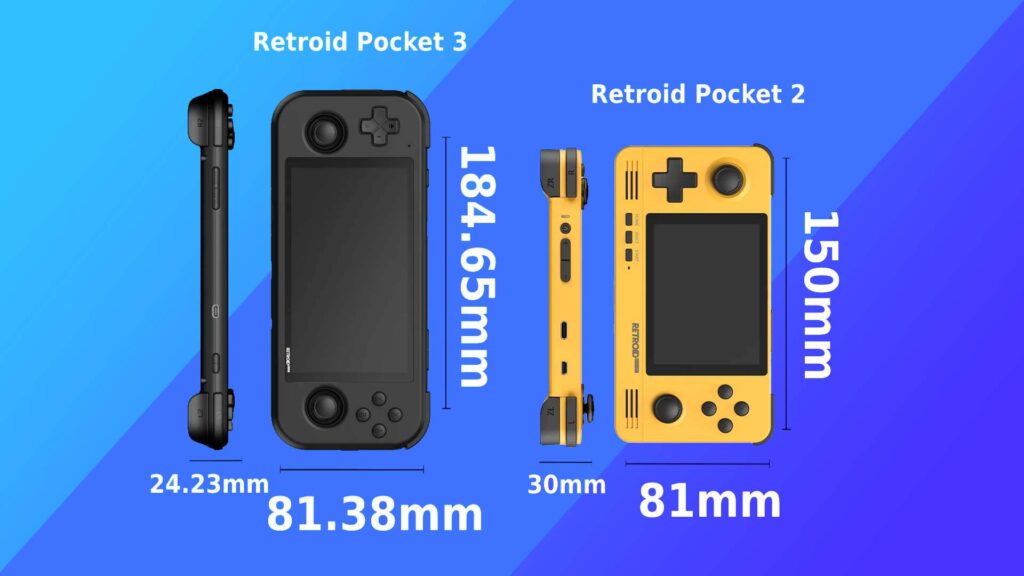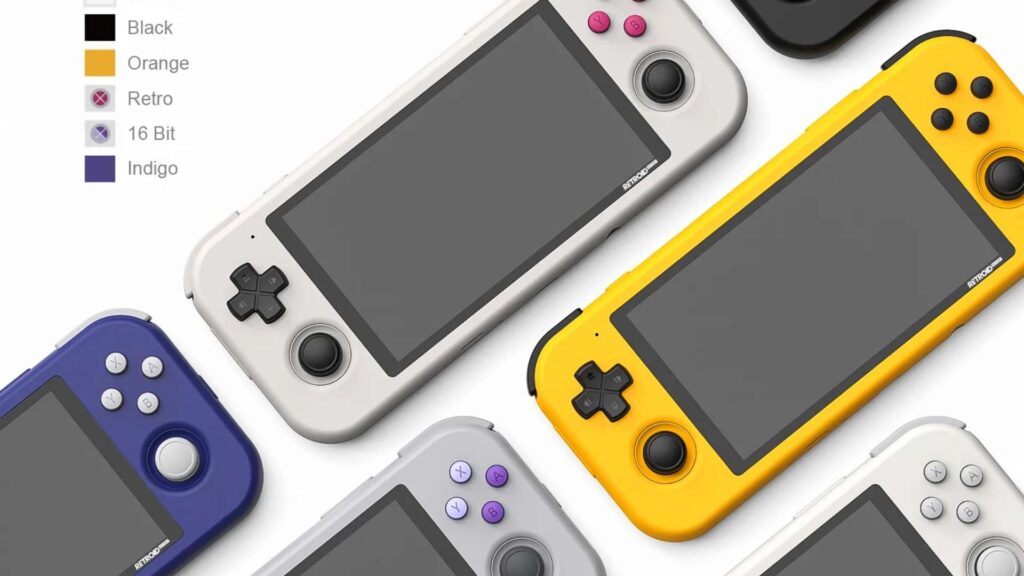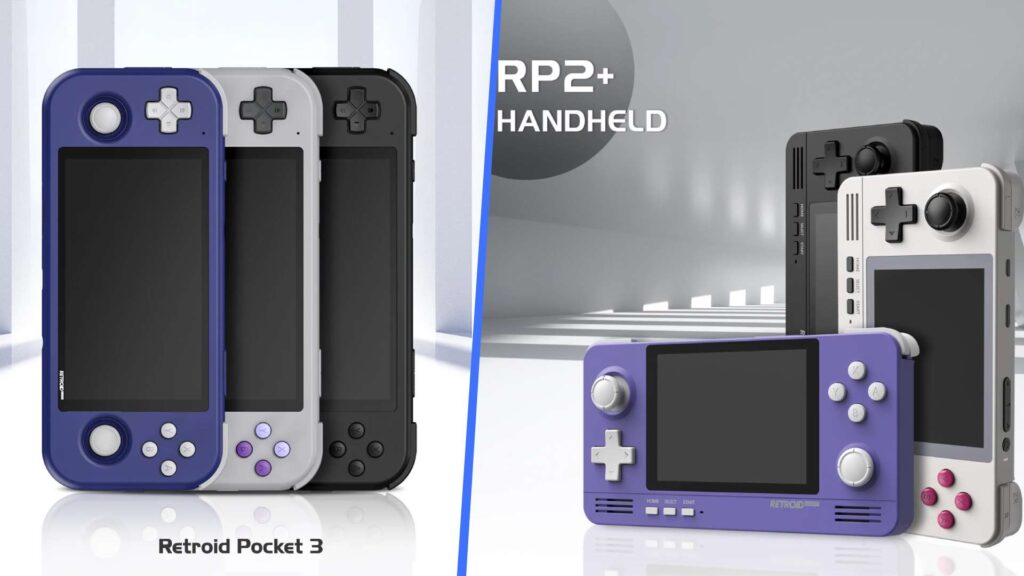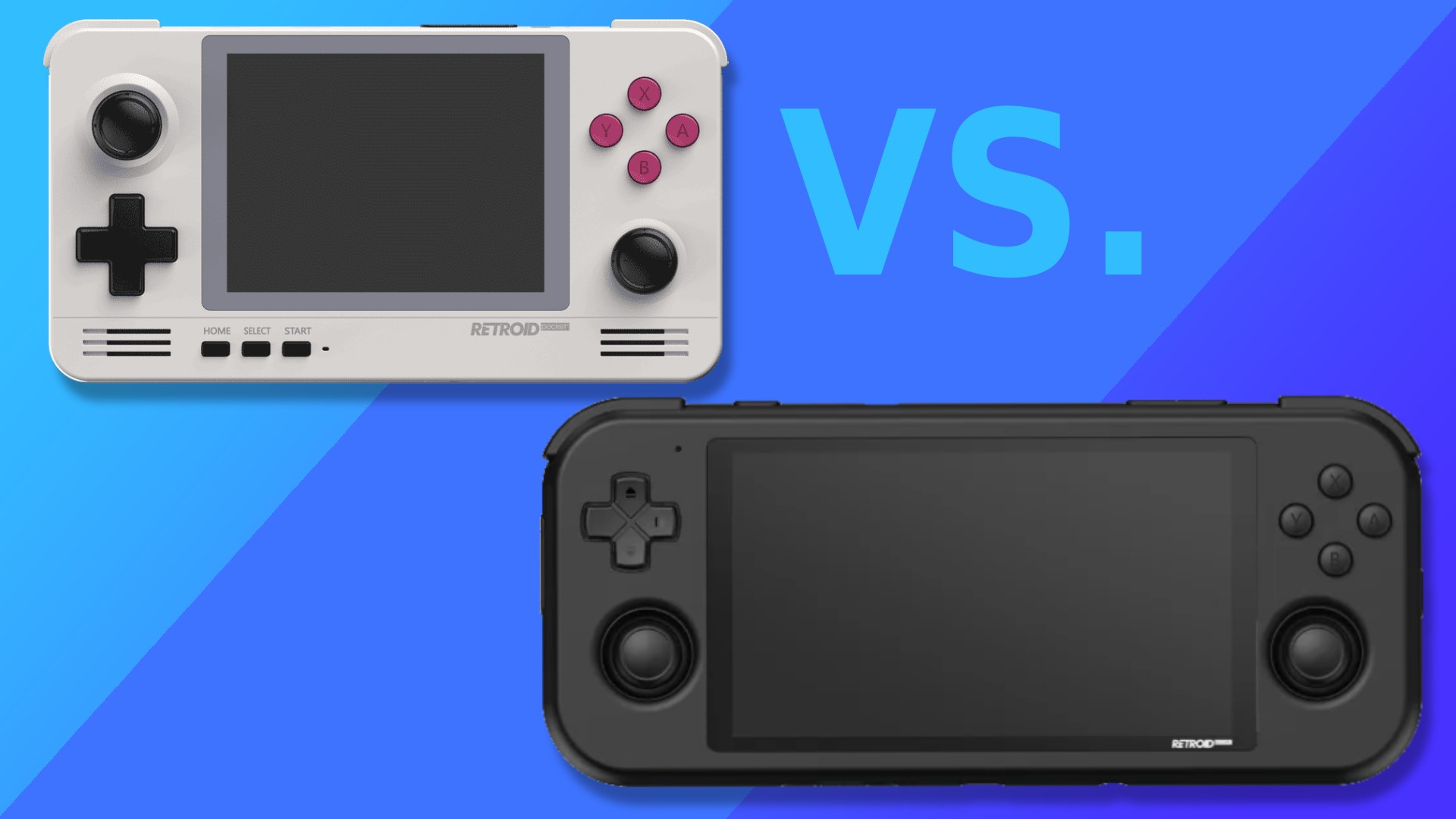Not sure which Retroid device is for you? Don’t worry, this guide will break down everything you need to know so the question of which console is right for you can be easily solved.
Retroid Pocket 2 vs Retroid Pocket 3

With two different Retroid handheld consoles now available worldwide, it’s worth taking a minute to work out which model is right for you. Is the smaller and cheaper Retroid Pocket 2 the right choice? Or maybe the slightly more expensive but larger and more powerful Retroid Pocket 3 if more your style?
In this guide we’ll explain the specs of each console and walk you through all the differences between the two versions.
Retroid Pocket 2 Plus Specifications

The main reason the Retroid Pocket 2 Plus took off was down to how well Retroid handled the device. On paper, the specs aren’t anything that impressive. 2GB of RAM for Android should result in lag and poor performance.
But, somehow, Retroid was able to take these lower specs and create a handheld that’s capable of running not just up to PS1, but also above that.
Dreamcast and N64 performance aren’t perfect, but you should be able to get a decent whack of the catalog working with minimal issues. Games like Marvel vs Capcom 2 run brilliantly.
And if you want a really big surprise, try playing the GameCube version of Luigi’s Mansion on the Retroid Pocket 2 Plus. This isn’t a GameCube handheld at all but you’ll be amazed by how well it runs.
- Chipset: Unisoc Quad-core Tiger T310
- GPU: PowerVR GE8300 at 800
- RAM: 2GB LPDDR4
- Android 9
- Storage: 32GB eMMc
- Screen Size: 3.5-inch touchscreen
- Battery 4000mAh
- Wi-Fi: 2.4G, 5G
Retroid Pocket 3 Specifications

You may have noticed some of the specs from the Pocket 2 and Pocket 3 are the same. You’re not misreading it, both the Retroid Pocket 2 Plus and Retroid Pocket 3 share the same chipset for the CPU and GPU solutions.
Where things differ between the two devices is when we look at the RAM and operating system.
RAM in the Retroid Pocket 3 is set at 2GB, the same as the Retroid Pocket 2, or for an extra 10 bucks can be upgraded to 3GB. That may not seem like much but when we’re talking about apps running alongside the Android operating system, any extra RAM is welcome.
Normally the minimum recommendation for Android is 4GB of RAM, and while the Retroid Pocket consoles are the exception to that rule, more RAM means better performance.
The biggest change between the two devices is the inclusion of Android 11 over Android 8.
Android 11 offers up an environment that’s around 20 to 30 percent faster than what we see in Android 8. In layman’s terms, what that means for emulation is more space for apps to draw power from, resulting in faster and cleaner performance. It’s a win/win.
- Chipset: Unisoc Quad-core T310
- GPU: PowerVR GE8300 at 800MHz
- RAM: 2GB/3GB
- Operating System: Android 11
- Storage: 32GB
- Screen: 4.7-inch touchscreen at 750 by 1334, up to 60hz
- Battery: 4000mAh
- Wi-Fi: 2.4Ghz, 5G
- Misc: Better heat dissipation than the Retroid Pocket 2
Retroid Pocket 2 vs Retroid Pocket 3: What Can Each Do?
Both consoles are Android-based, meaning playing games is as simple as opening a popular app – like ePSXe for example – and loading a game via the interface. Simple stuff.
But in terms of what’s possible on each system, there are some pretty stark differences despite both consoles housing similar tech.
For the Retroid Pocket 2, anything from the 8-bit and 16-bit systems will run beautifully. Same goes for PS1. Where performance starts to show some cracks is when N64, DS, and Dreamcast are thrown into the mix.
Although you can get some good results by tweaking in-emulator settings, 100 percent compatibility isn’t guaranteed. With GameCube, as we mentioned, only a handful of low-spec games will be playable. The rest are simply too much for the Retroid Pocket 2 to handle.
Retroid Pocket 2 Emulation
- Sega: Genesis/Mega Drive, Master System, Game Gear, SegaCD, Sega32x, some Dreamcast
- Nintendo: NES, SNES, Gameboy, Gameboy Advance, DS, some N64, some GameCube
- Sony: PlayStation 1
- Misc: PC Engine, WonderSwan, Mame, FBNeo, Neo Geo
As for the Retroid Pocket 3, there’s a lot of similar ground. Anything from the 8-and-16-bit era will work flawlessly. PS1 looks and runs great. But what about the rest? That’s where things get interesting.
Because of the switch to Android 11, and the extra performance boost that brings, Dreamcast and N64 are much more playable on the Retroid Pocket 3, as is PSP, although PSP is where the Pocket 3 taps out.
GameCube is better on the Pocket 3 but still isn’t at a point where it’s compatible enough to be considered a handheld that plays GameCube games. Is that an issue? Not really. There’s a price gulf between the Retroid Pocket 3 and the cheapest GameCube handheld in the AYN Odin ($199), so it’s an acceptable limitation.
Retroid Pocket 3 Emulation
- Sega: Genesis/Mega Drive, Master System, Game Gear, SegaCD, Sega32x, Dreamcast
- Nintendo: NES, SNES, Gameboy, Gameboy Advance, DS, N64, some GameCube
- Sony: PlayStation 1, PSP
- Misc: PC Engine, WonderSwan, Mame, FBNeo, Neo Geo
Retroid Pocket 2 vs Retroid Pocket 3: Price

The Retroid Pocket 2 Plus comes in at $99 while the newer Retroid Pocket 3 costs $119 for the 2GB RAM model and $129 for the 3GB RAM version.
We named the Retroid Pocket 3 the best handheld in the $100 to $150 price bracket because its power is miles ahead of every other console in that category.
Up against the likes of the Anbernic RG351 at $110, there’s no question about which is the better choice for gamers. The RG351 by comparison only offers up to PS1 emulation. So that’s no Dreamcast, no N64, and no DS.
We’d also wager the Retroid Pocket 3 is the one to beat at this point. It gets so much right while also keeping the cost as low as possible, something Anbernic isn’t keeping up with.
Whichever device you decide on, you’re going to get your money’s worth. We’ve checked out the competition and in this price bracket, Retroid really is the best way to go.
What About the Base Retriod Pocket 2 Model?
Before we jump into the full conclusion, it’s worth pointing out there are two different versions of the Retroid Pocket 2, and you only need to bother with one.
There’s the basic Retroid Pocket 2 and the Retroid Pocket 2 Plus. The latter of the two features newer tech on the inside which in turn makes it considerably more powerful than the basic model.
If you’ve picked one up in the last year, chances are you’ve got the Retroid Pocket 2 Plus as that’s the more commonly available model.
In short, don’t bother with the Retroid Pocket 2 base model. It’s outdated now.
Here are the Retroid Pocket 2 Base Model Specs in case you want to compare them:
- Chipset: Quad Core Cortex A7
- GPU: Mali 450 MP2
- RAM: 1GB LPDDR3
- Android 6.0/8.1
- Storage: 8GB eMMC
- Screen Size: 3.5-inch touchscreen
- Battery 4000mAh
- Wi-Fi: 2.4G
Conclusion
Although the Retroid Pocket 3 offers up more power and better performance over the Retroid Pocket 2, it all comes down to two main points.
First, do you care about playing Dreamcast and N64 in a more stable environment? If you do, the Pocket 3 is the better choice. The Retroid Pocket 3 is the more powerful of the two.
What we personally think is the most important factor here is the design of the two consoles. For an easy visual, would you rather play on a Game Boy Advance or a PS Vita? Forget the internals, just think about the shape of each console. That’s the choice here.
The Retroid Pocket 2 is more portable due to the smaller form factor, whereas the Retroid Pocket 3 increases the screen size and delivers a more hand-friendly device that takes its cues from the PS Vita.
Big screen or little screen? Slightly more power or a cheaper model? Those are the questions you need to ask yourself.
As for what we recommend, there’s no denying the Retroid Pocket 3 is a sumptuous example of how upgrades should be done. The extra power opens up new possibilities and the larger screen is a good call.
The screen isn’t as large as the more expensive AYN Odin or the monstrous Steam Deck, but neither is it your typical 2.5-inch screen most companies flock to. At 4.7-inches it’s the perfect middle ground for those looking for something meatier without becoming oversized.
So, which model is better? We’d have to go with the Retroid Pocket 3. The extra screen real estate married to the faster system really makes this device feel more modern than anything else in this price bracket. Sure, it’s not going to rival the AYN Odin, but at almost half the price, it doesn’t need to either.

